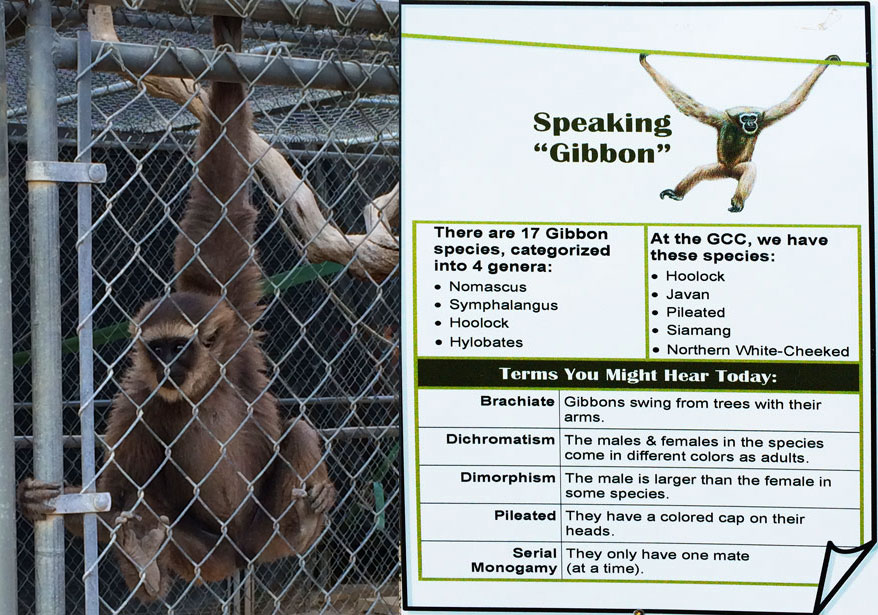This week our homeschooling foray took us to nearby Santa Clarita, for a  wonderful private tour of the largest conservation center for Gibbons in the western hemisphere. Gibbons are a delightful animal that my family knew very little about. But now, due in part to the dynamic tour guide Alma at the Gibbon Conservation Center (GCC), we feel like novice-experts. I believe, that is indeed the seed that every conservationists wishes to impart.
wonderful private tour of the largest conservation center for Gibbons in the western hemisphere. Gibbons are a delightful animal that my family knew very little about. But now, due in part to the dynamic tour guide Alma at the Gibbon Conservation Center (GCC), we feel like novice-experts. I believe, that is indeed the seed that every conservationists wishes to impart.  “The more you know,… the more you will care.” This couldn’t have been more evident, than in the middle of our tour, when our kids shared their desire to save the most endangered species of Gibbon in the wild, that are down to the last twenty in number. The children also discussed options on how to preserve habitats and still allow businesses to thrive that were presently devastating the homes of gibbons and other animals that live in jungles and forests. As a parent, I feel both pride and sadness over the responsibility that our children are taking to care for our planet. Points go to our tour guide for following the kid’s lead and dialoguing honestly and compassionately on this subject.
“The more you know,… the more you will care.” This couldn’t have been more evident, than in the middle of our tour, when our kids shared their desire to save the most endangered species of Gibbon in the wild, that are down to the last twenty in number. The children also discussed options on how to preserve habitats and still allow businesses to thrive that were presently devastating the homes of gibbons and other animals that live in jungles and forests. As a parent, I feel both pride and sadness over the responsibility that our children are taking to care for our planet. Points go to our tour guide for following the kid’s lead and dialoguing honestly and compassionately on this subject.
We can’t recommend this experience enough. Everyone in our group, age 1 year to 45 was engaged. Walking about the enclosures on such a lovely day, felt as if we were on National Geographic, observing beguiling primates swing and fly about in play as well as walk erect on the ground (looking more like humans than chimpanzees and great apes). And at the end of our tour, we experienced a crazy campus-wide concert of howling and crooning by most of the Gibbons, that I doubt any of us will ever forget.  If you act quick enough, you can get tickets or private tours from Groupon at half price that will not expire until spring. Even though the center is open to the public on the weekends, it was well worth it to have the entire complex to yourself by purchasing the midweek private tour Groupon .
If you act quick enough, you can get tickets or private tours from Groupon at half price that will not expire until spring. Even though the center is open to the public on the weekends, it was well worth it to have the entire complex to yourself by purchasing the midweek private tour Groupon .
In addition to serving as a sanctuary since 1976 (when Gibbon specialist, Alan Mootnick founded it), the GCC presently works with governments and conservationists in Southeast Asia to aid in restoring the Gibbon populations. Extra care is taken to allow the Gibbon’s to exist as close to their natural state as possible in order to effectively reintroduce their offspring to their natural habitats. This means there is no man-handling beyond medical-required attention. The true habits and characteristics of the Gibbons are honored. For example, the enclosures do not have artificial grass, faux rocks or fake foliage (which appeals to humans). Instead they are structurally sound and interlaced with tree trunks, ropes and swings to best allow the Gibbons to fly, jump, spin and yank as hard as they would on trees and vines in the jungles and canopies of their indigenous habitats. And boy are their acrobatics a delight to behold.
 In the wild, Gibbons do not travel in large numbers. A pair of parents rearing their children is the traditional “band” of Gibbons. Their young are nursed from 2- 3 years and live with their parents in a family unit similarly to us. The youngest baby at GCC is seen in the lap of the orange Gibbon pictured above. He clung adorably to his mother as we watched her swing from her perch to pick up some greenbeans and place one each in her feet and free hand, before using the other hand to swing and maneuver herself back to her original perch to snack upon her green goodies. Around 18 years of age, the offspring are pushed out of the family unit to ideally start their own family and stake out their own territory.
In the wild, Gibbons do not travel in large numbers. A pair of parents rearing their children is the traditional “band” of Gibbons. Their young are nursed from 2- 3 years and live with their parents in a family unit similarly to us. The youngest baby at GCC is seen in the lap of the orange Gibbon pictured above. He clung adorably to his mother as we watched her swing from her perch to pick up some greenbeans and place one each in her feet and free hand, before using the other hand to swing and maneuver herself back to her original perch to snack upon her green goodies. Around 18 years of age, the offspring are pushed out of the family unit to ideally start their own family and stake out their own territory.  At GCC, each enclosure that houses a nuclear family is covered with tarps, not only to offer shade in the hot seasons, but to create visual camouflage allowing each Gibbon families a sense of separation like from foliage and canopies in the wild.
At GCC, each enclosure that houses a nuclear family is covered with tarps, not only to offer shade in the hot seasons, but to create visual camouflage allowing each Gibbon families a sense of separation like from foliage and canopies in the wild.
The life expectancy of a Gibbon is between 30 and 40 years, and yet the oldest Gibbon is now 40 and still alert and active. Once the youngest at the center, he is now the oldest. (Pictured sitting on the log while a younger descendent plays flies about). Unlike Zoos, that typically feed their animals twice a day, Gibbons at the center are fed TEN times a day, similar to their feeding and grazing styles in the wild. Their varied diet is continuously modified by the workers and volunteers, once receiving two bananas a day it has been cut down to one, where as yams have been increased and they are considering increasing their protein in the form of nuts. They spend over 2 thousand dollars a month on feeding these spectacular animals.
At the center, they have experimented with forms of entertainment and enrichment in the enclosures like swings, hammocks, and toys as well as some lovely drums on the grounds that our kids played upon.  Interestingly enough, as I looked around to see the reaction, the drumming didn’t do a thing for the Gibbons, but made us visitors dance a bit.
Interestingly enough, as I looked around to see the reaction, the drumming didn’t do a thing for the Gibbons, but made us visitors dance a bit.
Each volunteer and employee at the center are keen on observing habits, health and interests of these fascinating creatures in order to improve the life of Gibbons at GCC, as well as in sharing with the international consortium of sanctuaries, zoos and conservation areas to ensure that the 17 species of Gibbons have the best possible outcomes. Get your Groupon now, or just make a donation to the Gibbon Conservation Center that works so hard to protect these animals, build awareness around the globe and is ensuring these species will NOT go extinct. If you have never purchased a Groupon before, you can use this link and give me a referral bonus.
